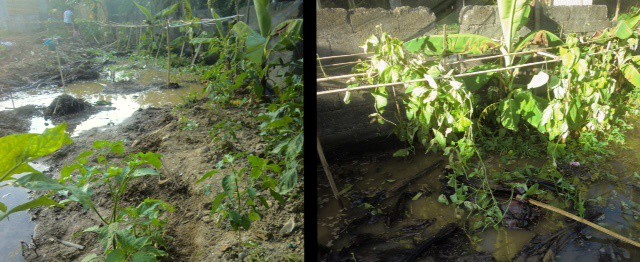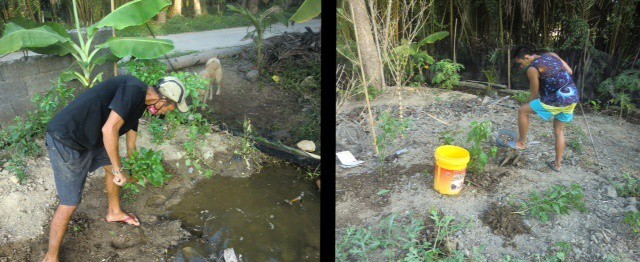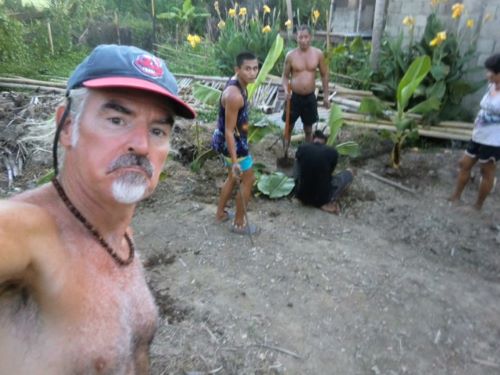Last Updated on May 27, 2023 by Ellen
One of the few activities that has been easily available to us here in Malay, Aklan, Panay, Philippines – as we wait out the COVID-19 crisis – has been working in our garden.
Of course, the garden actually belongs to the property owner, our landlord/hostess at the Hangout Beach Resort. But ever since we arrived, we’ve been welcome to join the staff as they worked to clear the nearby lot, prep and plant, water and weed, etc. They had just started the project when we arrived and were put into quarantine back in mid-March.
As gardeners in our previous lives, and for something productive and strenuous to do, Ellen, Mom, and myself have all joined in the effort. It’s been neat to witness the progress and see crops growing vigorously. Indeed, with the hot sunny weather, the plants have been flourishing.
But today — a disaster! Due to a very high tide, sea water somehow inundated a good portion of the garden. Many of the ‘oldest’ and largest plants were discovered soaking in more than a foot of standing salt water this morning. Not good.

From what we could determine, the super high tide pushed upstream in a nearby river then branched off into a small, dry, stream bed and went further inland – and eventually through a drainage pipe that goes under our beach access road and into the surrounding low-lying area, including parts of our garden.
I’m from the Great Lakes region of the USA; no tides or salt water. But obviously this was unexpected even by the folks who live here. And looking at the geography, it’s undoubtedly a rare occurrence. Still, even I know salt water can’t be used to irrigate crops.
Mom said the situation was “hopeless”. And indeed, a bunch of the bean, pepper, and banana plants along the ‘swampy’ roadside edge of the garden seemed to be already wilting. Still, a rescue operation was launched.
Shovels and hoes were put to work digging down around the roots and extracting many of the individual plants from the flood waters. About six of us worked quickly to transplant them.

Fortunately, about half the area remained dry and unaffected by the seawater swamp, as the whole center of the lot is crested up on a rise. New holes were dug and the big damaged plants squeezed in amongst the smaller seedlings on the higher ground.
I repeatedly filled and carried 5-gallon buckets of tap water from the faucet at the resort a couple hundred feet away. The sea soaked replants were given thorough fresh watering. Some of the green bean plants were also put into large, dirt-filled sandbags and heavily watered.
Personally, I felt like a LOT more water was needed to really flush the drooping vines. But there is no water hose option; we did what we could. A heavy natural rain would have been helpful, but none is forecast until Thursday – when the first tropical storm of the season arrives. Uhhggg!
Time will tell if the emergency transplanting and watering will allow any of the sea soaked crops to survive. Within a day or two we should have a pretty good idea as to the exact loss. Again, I have no experience in saving a garden after a salt water incursion, but the locals seem to have some confidence that it might be possible.

A couple bits of good news: there was one clump of high ground – almost like an island – growing a bunch of pepper plants which stayed dry. Those were replanted to the garden center and were spared any salt water. And also, thankfully, there are a lot of other plants – though smaller – which are still growing in the center high-ground too.
So while the freak sea flood did do serious damage to – and may yet kill – many of the most mature vegetable plants, there will still be crops and some kind of harvest. Too bad at the loss of weeks worth of effort and growth. It will be interesting to see if our emergency ‘swamp surgeries’ managed to salvage anything from the salt water… and what happens with the tropical storm. Stay tuned.
As always, be thankful and generous, happy trails, & more beer.
Life is NOW!
Thanks for reading, “Seawater swamp in the garden.”
Visit the COVID-19 page for more lockdown stories, and some resources to help you plan your travel — when borders reopen.
Earth Vagabonds post something every day from lockdown life in the Philippines. Come back to visit!

